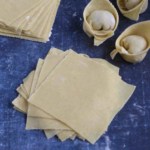Homemade Wonton Wrappers
Making wonton wrappers is easier than you might think! Follow this foolproof recipe to achieve the perfect look and texture.
Servings: 40 wrappers
Calories: 16kcal
Equipment
- Pasta maker
Ingredients
- All-purpose flour double weight of the egg whites (see note 1)
- ¼ teaspoon salt
- 2 large egg whites
- ½ teaspoon lye water (see note 2)
- Cornstarch for dusting (see note 3)
Instructions
Make the dough
- Mix all-purpose flour and salt in a mixing bowl. Pour egg whites and lye water over. Use chopsticks, or a fork, to stir and mix until no more liquid or loose flour can be seen.
- Combine with your hand to form a cohesive dough. Cover tightly with plastic wrap and allow it to rest for 30 minutes or so.
Roll the sheets
- Knead the dough again to make it smoother, then divide it into two equal portions. Work with one piece first and keep the other well-wrapped.
- NOTE: In the following steps, remember to lightly dust the dough with cornstarch from time to time to prevent sticking.
- Flatten the dough into a squarish shape that is thin enough to go through the pasta maker on its widest setting, which is usually the lowest number.
- Feed the dough through the machine, then fold it from both ends and pass it through another two to three times, making sure that the dough sheet eventually reaches the full width of the roller.
- Gradually reduce the thickness by turning the setting one number higher at a time, and pass the dough sheet through the roller twice at each setting. Handle the dough gently and dust it with cornstarch regularly.
- My pasta machine has settings from 0 to 9, I stop at No. 7 which results in a thickness of 0.8mm. Please feel free to adjust this to your preference (see note 4).
Cut the wrappers
- Dust the finished dough sheet lightly and evenly with cornstarch. Carefully fold the long sheet accordion-style into a stack, then cut it along the middle line to create two narrow, long sheets.
- From these, cut out square wrappers, aiming for approximately 40 pieces in total.
Store the wrappers
- Use the wrappers immediately, or stack them up and store them for later use.
- Keep them in airtight bags or containers to prevent drying out. Store in the fridge for up to 2 days and 2 months in the freezer (defrost in the fridge before using).
Video
Notes
1. For example, if 2 egg whites weigh a total of 3 oz (85g), then you’d need 6 oz (170g) of flour.
2. Lye water (Kansui/枧水) can be found in Chinese stores. Or, you can make it at home with baked baking soda.
3. You may use cornstarch or other types of starch (like potato, sweet potato, or tapioca starch) to prevent sticking. Flour is not recommended for dusting.
4. Adjust the thickness of the wrappers based on the type of wonton dish you are making. For example, thinner wrappers are ideal for wonton soup, while thicker wrappers are better suited for deep-fried wontons.
Nutrition
Serving: 1wrapper | Calories: 16kcal | Carbohydrates: 3g | Protein: 1g | Fat: 0.04g | Saturated Fat: 0.01g | Polyunsaturated Fat: 0.02g | Monounsaturated Fat: 0.004g | Sodium: 17mg | Potassium: 7mg | Fiber: 0.1g | Sugar: 0.02g | Calcium: 1mg | Iron: 0.2mg
